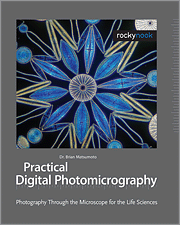 Santa Barbara, CA—Practical Digital Photomicrography (Rocky Nook, $69.95 USD) is an introduction to digital photography through the microscope in which readers will learn about the three camera types used in photomicrography (point and shoot consumer cameras, digital single lens reflex cameras, and professional (scientific) photomicrography instruments) and the advantages and disadvantages of each. For example, the point and shoot camera has the benefit of a live, real-time preview, active histogram, potential infrared sensitivity, low cost, and video recording capability. Its disadvantages are noise at low light levels and limited dynamic range.
Santa Barbara, CA—Practical Digital Photomicrography (Rocky Nook, $69.95 USD) is an introduction to digital photography through the microscope in which readers will learn about the three camera types used in photomicrography (point and shoot consumer cameras, digital single lens reflex cameras, and professional (scientific) photomicrography instruments) and the advantages and disadvantages of each. For example, the point and shoot camera has the benefit of a live, real-time preview, active histogram, potential infrared sensitivity, low cost, and video recording capability. Its disadvantages are noise at low light levels and limited dynamic range.
A digital single lens reflex has, at low magnification, the advantages of an accurate and sharp focusing screen, low noise at low light levels, and good dynamic range. This camera provides the potential of equaling the quality of scientific cameras but at a fraction of the cost. Its only weakness is the ergonomic deficiencies resulting from having the camera mounted on a microscope.
The scientific grade cameras provide the highest image quality with ease of operation. Unfortunately, such cameras are expensive ($6000) and are found, most commonly, in research laboratories. However, such cameras are still within the financial reach of enthusiasts who can afford a professional-level digital single lens reflex. Prices for these types of cameras are dropping and it is anticipated that cameras of this type will be available at $2000-3000 in the next year.
A thorough presentation will be made of the methods of attaching the cameras to the microscope and the ergonomics of image acquisition, as well as detailed discussions on microscope illuminators and lighting systems, so that the reader understands such basic image acquisition procedures as obtaining white balance, determining resolution, and edge enhancement. There will be chapters on imaging transparent specimens using darkfield, phase contrast, differential interference contrast, oblique illumination, and Rheinberg illumination.
These skills will enable the reader to obtain professional results and will be valuable to the professional photomicrographers as well as the photographic enthusiast.
For a review copy or more information please email rockynookpr@oreilly.com. Please include your delivery address and contact information.
About the Author
Dr. Brian Matsumoto received his Ph.D. in Anatomy and Cell Biology from the University of California at Los Angeles in 1981. His research required the development and refinement of techniques for transmission electron microscopy and light microscopy. These tools were used to study the role of actin and microtubules in photoreceptor membrane transport and assembly. From 1992 to 2009, Dr. Matsumoto served as Director of the Integrated Microscopy Facility, a unit administered by the Neuroscience Research Institute and the Department of Molecular, Cellular, and Developmental Biology. This facility provides instruction and support for projects that require advanced imaging. In addition, he served as the instructor for MCDB 220, a graduate level course for digital microscopy at the University of California. He has strengthened the ties between the University and industry by working with such companies as Olympus of America, Media Cybernetics, Q-Imaging, Jackson ImmunoResearch, Prior Scientific, and Image Content Technology. Together, they have developed a digital imaging course that is open to attendees throughout the United States.
Additional Resources:
For more information about the book, see:
http://www.oreilly.com/catalog/9781933952079
Practical Digital Photomicrography
Publisher: Rocky Nook
Dr. Brian Matsumoto
ISBN: 9781933952079, 250 pages,
Book Price: $69.95 USD
order@oreilly.com
1-800-998-9938
1-707-827-7000
About Rocky Nook
Rocky Nook's books are distributed internationally by O'Reilly Media.
Rocky Nook was founded in early 2006 in Santa Barbara, California, and is closely associated with dpunkt.verlag, a leading publisher of books on technology based in Heidelberg, Germany. The focus of Rocky Nook's publications is on digital photography and computing.
About O’Reilly
O’Reilly Media spreads the knowledge of innovators through its books, online services, magazines, and conferences. Since 1978, O’Reilly Media has been a chronicler and catalyst of cutting-edge development, homing in on the technology trends that really matter and spurring their adoption by amplifying “faint signals” from the alpha geeks who are creating the future. An active participant in the technology community, the company has a long history of advocacy, meme-making, and evangelism.